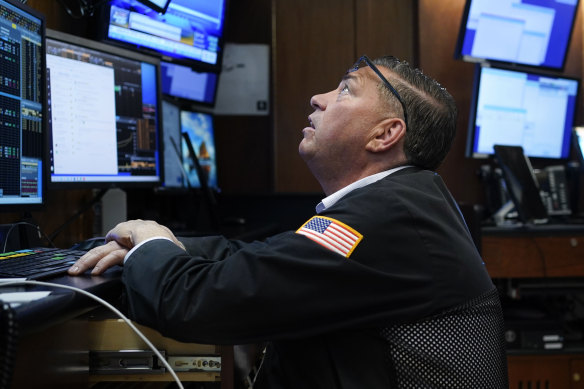ASX defies weak US lead to stay in the green
By Millie Muroi
Australian shares have slipped slightly but remain in the green, buoyed by information technology and financials sectors, despite a weak lead in from Wall Street where investors mulled stubbornly high inflation and the prospect of further rate rises in 2023.
The S&P/ASX200 was up 78.6 points, or 1.1 per cent, to 7,024.8 at midday, as all sectors except energy traded higher.
Early gains by Charter Hall Social Infrastructure and Brainchip Holdings in the real estate and information technology sectors were surpassed by lithium miners like Sayona Mining (up 7.9 per cent) and battery materials and technology company Novonix (up 7.3 per cent) by midday.
Meanwhile, energy companies remain in the red after oil prices dropped in their biggest fall in more than month. Woodside Energy declined 1.8 per cent, while coal miners New Hope Corporation and Yancoal shed 0.8 per cent and 1 per cent respectively.
All other sectors were in the green, led by information technology (up 2 per cent) and financials (up 1.5 per cent). Commonwealth Bank, NAB and Westpac all traded higher.
The Australian 10-year yield fell 7 basis points and the 10-year Treasury yield steadied after its biggest decline in more than a month.
On Wall Street, stocks gave up early gains and ended the first session of 2023 lower, just days after the S&P 500 index closed the books on its worst year since 2008.

The S&P 500 shed a 1 per cent gain and finished 0.4 per cent lower on Tuesday. The Dow Jones Industrial Average slipped less than 0.1 per cent and the Nasdaq composite dropped 0.8 per cent. Small-company stocks also lost ground, pulling the Russell 2000 index 0.6 per cent lower.
Technology stocks were among the biggest weights on the market. Apple fell 3.7 per cent, after a Nikkei Asia report indicated slumping demand and staff shortages in China, leaving the iPhone maker’s market value below $US2 trillion for the first time since March 8, 2021. At the time, shares in the company fell nearly 27 per cent, their first annual decline in four years amid a broad slide in technology stocks.
Long-term bond yields fell significantly. The yield on the 10-year Treasury, which influences mortgage rates, fell to 3.8 per cent from 3.9 per cent late Friday. Stock and bond markets were closed Monday for the observed New Year’s Day holiday.
The Fed will release minutes from its December policy meeting on Wednesday, potentially giving investors more insight into its decision-making process and thoughts heading into 2023. The central bank’s next policy decision on interest rates is set for February 1.
Markets will be watching the extent to which central banks around the world continue to lift their cash rates in a bid to curb inflation, and the potential for such changes to trigger higher unemployment and recession. The Fed’s key lending rate stands at a range of 4.25 per cent to 4.5 per cent after rocketing from a range of 0 per cent to 0.25 per cent at the beginning of 2022. The US central bank forecasts that it will reach a range of 5 per cent to 5.25 per cent by the end of 2023, and doesn’t expect a rate cut until 2024.
That’s despite a falling 2-year US Treasury yield, an indicator of future interest rates and inflation, signalling investors’ expectations for a trimming of interest rates as early as this year.
Investors are also looking ahead this week to several updates on the employment market, which has been a strong area of the broader economy. That has helped buffer the economy from a recession, analysts have said, but it also makes the Fed’s fight against inflation more difficult and raises that risk that it could go too far and bring on a recession.
The government will release a report Wednesday on job openings for November, followed by a weekly report on unemployment on Thursday. Markets are also anticipating a monthly report on the US job market on Friday that could provide clues on where the biggest economy in the world is headed, as well as corporate earnings reports which are set to start being released in greater numbers in mid-January.
“If we get a weak report, that would be a boost to the market because it might imply that the Fed will ease back a bit on the rate hikes,” managing director of trading and derivatives at Charles Schwab, Randy Frederick said.
Wall Street is also waiting on the latest round of corporate earnings reports, which will start flowing heavily around the middle of January. Analysts polled by FactSet expect earnings for companies in the S&P 500 to broadly slip during the fourth quarter and remain flat for the first half of 2023.
Bleak factory activity data from China dragged down US oil prices which closed 4.1 per cent lower on Tuesday, weighing on American energy companies. Hess fell 5.1 per cent. Meanwhile, gold producer Newmont rose 5 per cent, the biggest gain in the S&P 500, as prices for the precious metal rose.
Facebook parent Meta Platforms rose 3.7 per cent to lead a rally in communications services stocks. Gains in several big banks and other financial stocks also helped keep the market’s losses in check. Wells Fargo rose 1.2 per cent.
Tesla plunged 12.2 per cent for the biggest decline among S&P 500 stocks after the electric vehicle maker’s 2022 sales disappointed investors.
Markets in Europe and Asia gained ground.
With Associated Press
Most Viewed in Business
Source: Thanks smh.com